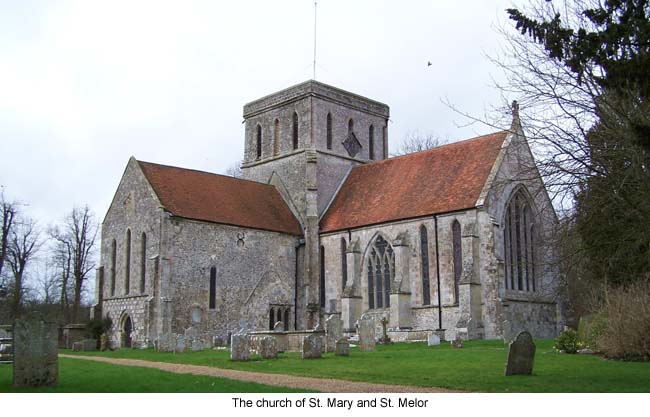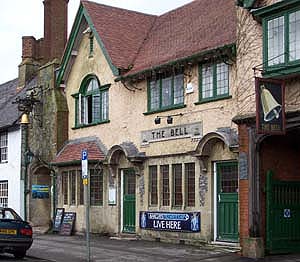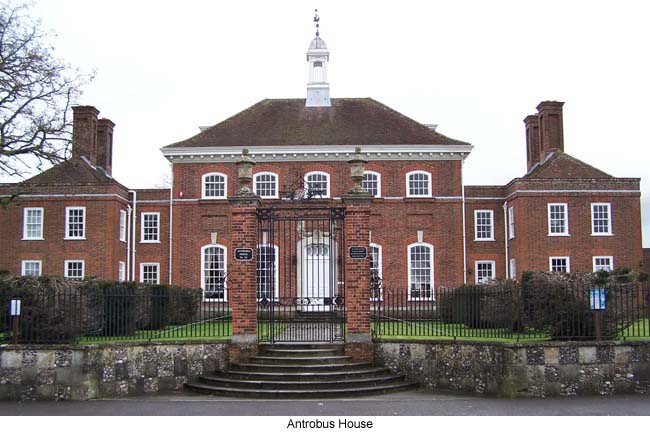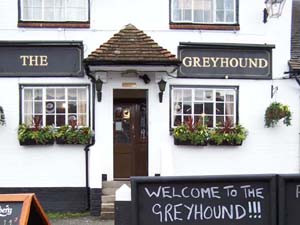Amesbury: A Stepping Stone to History
by Pearl Harris
For most people, Amesbury is merely the nearest town to
Stonehenge. However, this pretty little Wiltshire town is steeped
in history, and is a lot more than a mere stepping stone.
Situated 9 miles north of Salisbury and 14 miles west of
Andover, Amesbury has a population of 28,000 and lies in the
heart of Salisbury Plain, an area inhabited by man for over 4000
years. It has also been known as "Ambrosbury", "Ambresbury" and
"Amblesberie" at various times in the past. This has been a
center of Christian worship for centuries. There is reference in
the Welsh Triads of a great monastery of 300 monks, known as the
"Choir of Ambrosius", situated here.
Ambrosius Aurelianus, the 5th-century founder of this monastery,
was the leader of several British tribes who opposed the
ferocious Saxon invaders for many years. He established his
headquarters in this region and the area became "Ambrose Burgh."
Some people believe that the name Amesbury is derived from this.
If the legend of Queen Guinevere has any historical basis, it is
to this "holy house of Almesbury", as described by Tennyson, to
which she was banished and later died.
In the 6th century, the
monastery was destroyed by pagans, but there is evidence of a
Saxon church that replaced it. Records show that a Synod was held
here in King Edgar's reign under Archbishop Dunstan.

The history of the present parish Church, the "Abbey Church
of St. Mary and St. Melor" or the "Amesbury Abbey
Church" as it is variously known, dates back to 979, when
Queen Elfreda founded a Benedictine Abbey, supposedly in
expiation of her crime for being the cause of the murder of her
stepson, King Edward, at Corfe Castle. After the murder, Queen
Elfreda's son, Ethelred, became King. There is no evidence that
she was indeed involved in Edward's murder, but in those days the
founding of religious establishments was a recognized form of
doing penance. Amesbury Abbey was a modest establishment,
dedicated to St. Mary, and also to St. Melor, a boy saint of
Brittany, murdered by his uncle in strangely similar
circumstances to King Edward's murder. Legend has it that the
remains of St. Melor were brought to Amesbury in Saxon times. The
Abbey of Amesbury, by all accounts, appears to have been a very
important one and was mentioned in the Will of King Alfred.
Amesbury celebrated a millennium year in 1979, a thousand years
after the establishment of the Abbey. In 1995 the Church also
celebrated the millennium of the auspicious occasion on Easter
Day 995, when the Bishop of Wiltshire was made Archbishop of
Canterbury in the presence of King Ethelred.
In 1175, the year in which Thomas a'Beckett was murdered in
Canterbury Cathedral, Henry II was the King involved in the
murder. He was offered absolution by the Pope on condition that
he founded three abbeys. He found excuses to evict the
"English" nuns at Amesbury Abbey and started to
refurbish the Abbey on a grand scale. In 1177, King Henry II
re-founded the Abbey as part of the Order of Fontevrault,
extending the buildings. Royal favor was enjoyed by the Abbey
during the ensuing centuries, with further extensions taking
place.
 In 1283, King Edward I's
daughter, Mary, entered the Convent, where she spent the rest of
her life. In 1287, King Edward's mother, Eleanor of Provence,
also took her vows and was later buried here. The precise
location of her grave remains unknown, making her the only Queen
of England without a known grave. In 1501, Katherine of Aragon
stayed in the Abbey on her way to London for her marriage to King
Henry VIII's elder brother, Prince Arthur. In 1283, King Edward I's
daughter, Mary, entered the Convent, where she spent the rest of
her life. In 1287, King Edward's mother, Eleanor of Provence,
also took her vows and was later buried here. The precise
location of her grave remains unknown, making her the only Queen
of England without a known grave. In 1501, Katherine of Aragon
stayed in the Abbey on her way to London for her marriage to King
Henry VIII's elder brother, Prince Arthur.
At the time of the Reformation, the Abbey was dissolved and many
buildings destroyed. The lands were granted to the Seymour
family, Henry VIII having married Jane Seymour in 1536. The Abbey
Church was given to the people of Amesbury, who up to the present
time have been allowed to use part of the Abbey as their parish
church. Sadly, little remains of what must have been a
noteworthy monastic site. The whereabouts of the relics of St.
Melor and the body of Queen Eleanor remain a mystery. However,
a few important links with the past have endured.
The Amesbury Psalter, a beautifully illustrated book of Psalms
written in the 13th century is presently in the possession of the
Library of All Souls, Oxford. A fragment of a Saxon wheel-headed
cross is on display in a glass case and thought to date back to
Elfreda's foundation of the Abbey in 979. It was recreated and
placed in the center of Amesbury during the Millennium
celebrations.
The outer walls of the flint and stone cruciform church building
reveal evidence of a much larger medieval construction. The
interior has an aura of simplicity and light. The main entrance
leads to the 15th-century south aisle with a decorated wagon roof
and the font with a Norman bowl of Purbeck stone on a
15th-century base. The nave is mainly Norman, with 16th-century
carved oak beams.
The 15th-century Amesbury Clock is housed within the north
transept. This is one of the earliest known examples of British
clock-making skills. The two oldest church bells date from 1619,
whilst the two newest commemorate World War II.
This historic church continues its centuries-old links to Royalty
to this day, falling under the patronage of St. George's Chapel,
Windsor. HRH Prince Charles has visited the church on two
occasions, once to plant a tree in commemoration of the
millennium in 1979 and once to attend a musical concert. The
Abbey Church is open daily throughout the year for services from
April to September and visitors are always welcome.

Amesbury town itself has increased greatly in recent years, with
new housing estates having been constructed. However, the old
centre has lost nothing of its former charm. In the quaint town
center, architecture dating from the 19th, 18th, and earlier
centuries help it to retain its original character. Former
oil-lighting brackets may be seen on the wall of the building in
High Street, opposite Barclay's Bank. Sadly, most of the original
thatched roofs have disappeared, but two are to be seen near the
library and one near the church.
High Street and Church Street with their travelers' inns would
have catered to the east-west traffic through the ages, and
Salisbury Street was once the site of the weekly town market. A
classical mansion, known as Amesbury Abbey, is built on the
original site of the abbey and is now a private nursing home.
West Amesbury, previously known as "Little Amesbury",
contains charming thatched and timbered cottages. West Amesbury
House is a 17th century residence with mullion windows. It
contains the remains of a medieval house, which is thought to
have been associated with the Priory at Amesbury.
 In
May 2002, the phenomenal discovery was made of the richest Bronze
Age burial site ever excavated in Britain. The grave of a man
dating to around 2,300 BC was revealed during excavations for a
housing development in Amesbury and the man was called by the
media "The Amesbury Archer" or the "King of
Stonehenge". In
May 2002, the phenomenal discovery was made of the richest Bronze
Age burial site ever excavated in Britain. The grave of a man
dating to around 2,300 BC was revealed during excavations for a
housing development in Amesbury and the man was called by the
media "The Amesbury Archer" or the "King of
Stonehenge".
Experts believe that the "Amesbury Archer" originally
came from either the German, Swiss or Austrian Alps. Later, the
grave of a younger man, probably the Archer's son, was discovered
nearby. Both were apparently of aristocratic status, as the two
graves contained over one hundred objects including arrowheads,
copper knives and gold earrings.
The Trafalgar Clumps may be seen just west of Amesbury on the
A303 bypass. These beech trees were planted about 200 years ago
to represent the alignment of the French and British ships at the
Battle of the Nile. Their planting on the estate of the Duke of
Queensbury is thought to have been at the instigation of Lady
Emma Hamilton, Lord Nelson's mistress, who befriended the Duke
after Nelson's death.
One mile west of Amesbury is a concealed Iron Age hill fort,
known as Vespasian's Camp, after the Roman general and later
Emperor, who campaigned in this part of Britain. This fort has
never been excavated.
The visitor to Stonehenge is well advised to linger longer in and
around the fascinating town of Amesbury which, for centuries, has
been a travelers' haven. As well as containing a veritable
historic treasure trove, Amesbury provides a host of modern
services, good restaurants and high quality accommodation for the
21st-centruy traveler.
Related Articles:
- The Eternal Mystery of Stonehenge, by Pearl Harris
- https://www.timetravel-britain.com/articles/stones/stonehenge.shtml
- Stonehenge: The Giants' Dance, by Sue Kendrick
- https://www.timetravel-britain.com/articles/stones/stonehenge1.shtml
More Information:
We regret that we no longer have the resources to maintain up-to-date links and/or hours and pricing details for the various sites and attractions listed on this website. For more information about the location(s) listed above, please use your favorite search engine or visit Wikipedia.
Pearl Harris, whose ancestors hail from Britain, was born in South Africa. In 2002, she emigrated to the Czech Republic with her husband, their dog and cat. Pearl resides permanently in the Czech Republic where she works as a freelance travel writer, English teacher and proof-reader. Her main passion is travel. Having traveled extensively in Africa, Europe,the USA and UK, she never intends to stop. Other interests are pets, photography, reading and writing. Pearl, a retired Diagnostic Radiographer, has a B.A. in English and Linguistics, post-graduate Diploma in Translation and TEFL qualification. Her only daughter, a professional photographer, lives in New Orleans.
Article ©2007 Pearl Harris
Photos courtesy of Salisbury and Stonehenge Tourism Partnership/Bryn Jones
|
